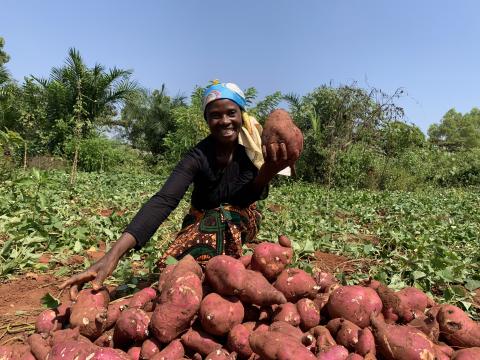DR Congo: Local Food – An Added Value for School Meal Diversification in Grand Kasai

By Pascaline Milemba, Communications Officer
During the third quarter of 2025, the school feeding programme implemented in Greater Kasai stepped up its strategy to diversify school meals by promoting local agricultural production. This integrated approach aims not only to improve the nutritional value of school meals but also to strengthen the self-reliance of the beneficiary communities.
In the Miabi health zone, located in the Kasaï Oriental province, Albert Dibondo, an agronomist working on the project, reported a varied and promising harvest for this quarter. Among the crops gathered were OBAMA-variety cassava leaves, cassava tuber roots, cowpeas (niébé), Chinese cabbage, sweet potato leaves, and more.
“These crops were selected for their resilience and nutritional value. The choice of cowpeas, for instance, follows their strong acceptance in the local diet. Moreover, they are already deeply rooted in local food habits,” he explained.
Community Momentum Grows
In Luiza territory, Kasaï Central province, specifically in the Masuika health zone, Engineer Gauthier Nzangi noted significant progress. A shift has been made in crop selection.
“Over the past three months, we’ve grown cowpeas, sweet potatoes, and okra. This choice reflects both crop rotation and protein needs. Since the project was launched, these productions have been adjusted, and they are now inspiring local households,” he said.
In Lomami province, Kabinda health zone, agronomist Godefroid listed Chinese cabbage, okra, sweet potato tubers, cowpeas, tomatoes, and amaranth as the main local crops. Their selection was based on economic criteria.
“These products were chosen for their profitability on the local market, which provides an additional motivation for the families involved,” he explained.
School Meals as an Educational Tool
Beyond agriculture, a broader educational approach revolves around school meals, according to Paulin Tshibang, school feeding programme coordinator in Greater Kasai. He confirmed that produce from community, market, and school gardens is directly used in children’s meals.
“This not only enhances the nutritional impact but also the variety of meals offered to the children,” he stated.
What Happens During School Holidays?
As the school year draws to a close in most pilot schools, a pressing question arises: what will become of the programme in the absence of school facilitators? To this, Paulin offers reassurance:
“The communities have fully embraced the initiative. Community focal points have been designated in each school. All necessary measures have been taken to ensure they take over during the holidays. The harvested produce will either be sold—where storage isn’t possible—and the proceeds managed by the parents’ committee to support the school’s needs, or stored until classes resume,” he explained.
A Model of Community Resilience
In short, the school feeding programme in Greater Kasai goes far beyond simply feeding children. It helps build more self-sufficient, resilient, and engaged communities. Through a harmonious combination of local production, nutrition education, and community participation, the project has proven to be a powerful lever for sustainable development.